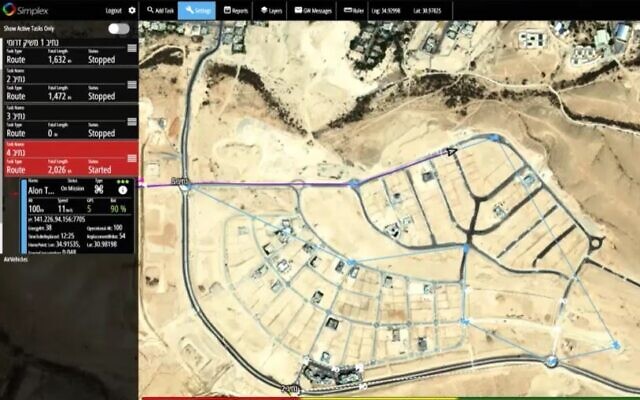Israeli startup Sightec said Wednesday it has achieved a “worldwide first” with a civilian drone flight that managed to successfully get to its destination in an area without GPS and beyond the experimenters’ line of sight, using computer vision and artificial intelligence technologies.
The test flight was part of a tender issued by the drone delivery pilot program operated by Israel’s Ministry of Transport (MOT), Ayalon Highways, the Civil Aviation Authority of Israel (CAAI) and Israel Innovation Authority, for testing and demonstrating drone technologies in managed airspace.
The success of the test is an important milestone towards the approval of drone delivery operations in Israel, said Roy Shmuel, the CEO of Sightec.
The Tel Aviv-based startup has developed software, called NavSight, that can be used with any off-the shelf drone equipped with a camera. The software turns the cameras into smart affordable sensors that enable the drone to “see and understand its surroundings” like the human pilot, using video processing technology to help the drone identify its location in real time.

Aerial view of the Sightec drone test flight over Yeruham (Courtesy)
GPS signals are not always available, said Shmuel in a phone interview, or they can be disrupted by satellite malfunction, solar flares or even malicious hacking. This makes it critical to develop other forms of navigation, reducing the dependence on GPS, he said, especially in the case of drones, which could crash without the signal, endangering people and buildings.
“We give drones the ability to get from point A to point B safely,” he said, without the need for GPS signals. “There is no available solution today for players globally.”
Before the flight, the route is pre-programmed into the drone, but if GPS fails, the camera turns on automatically and acts like a sensor. This allows the drone to visualize its surroundings in real time — matching what it sees with a map — and pinpoint its own location, both in day and night missions. The technology is able to detect and classify ground and aerial objects, as well as perform 3D mapping, to fully understand its environment. The vehicle is then able either to land safely in emergency mode or get to its final location without use of the GPS or a human pilot, said Shmuel.
During the pilot flight on Sunday, Sightec’s technology navigated the drone successfully on five pre-determined routes near the southern city of Yeruham. “The drone completed each route safely, from take-off to full landing, over desert and construction sites,” Shmuel said.
The test was conducted as part of a tender process held by Ayalon Highways, which has been scouting for technologies that resolve the threat of GPS disruption in drone operations. Sightech and its partner in the initiative, Simplex Interactive, were selected to demonstrate their technology. Simplex has developed a drone operating system which allows operation of multiple drones beyond visual line of sight and in shared airspace.
Sightech’s software integrates algorithms based on academic research led by Prof. Joseph Francos at the department of electrical and computer engineering at Ben-Gurion University of the Negev.
In upcoming quarters, the startup will conduct additional pilots of its technology in a variety of locations in Israel, Shmuel said.
Sightec was founded in 2017, and its clients include drone and avionics integrators for reconnaissance and Homeland Security missions such as Israeli Aerospace Industries (IAI) and Elta Systems, along with drone integrators in a wide range of civil applications including delivery, mapping, security and first responders, the company said in a statement.
Related posts:
Views: 0
 RSS Feed
RSS Feed

















 February 10th, 2021
February 10th, 2021  Awake Goy
Awake Goy  Posted in
Posted in  Tags:
Tags: 
















